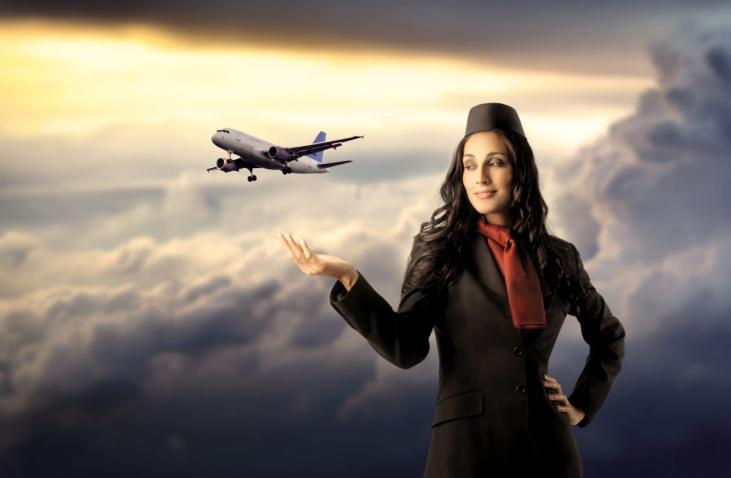
Credit: Thinkstock
I opened this book warily. My reading in cultural history has usually left me hungry for analysis of the structural levers of cultural change. In this case, however, I’m well satisfied. The Jet Sex: Airline Stewardesses and the Making of an American Icon rests on extraordinarily broad research, drawing not only on the popular press but also on corporate archives, government documents, and the testimony of hundreds of former airline stewardesses who provided interviews, letters, diaries and other memorabilia. While Victoria Vantoch’s core narrative focuses on the evolution of the stewardess as an icon, she situates that story in its social, political and economic contexts, which frequently take center stage.
From the moment airline companies began to employ women for in-flight passenger service, they cared deeply about stewardesses’ image. As one executive explained, when Boeing Air hired the first US stewardesses in 1930, “the flapper type of girl” need not apply. Initially, only trained nurses qualified for the job, and they had to be unmarried. After World War II, when in-flight service became a virtually all-female occupation, stewardesses no longer had to be nurses, but the no-marriage policy persisted, and airlines adopted elaborate hiring qualifications with regard to personal appearance. Successful applicants had to be pretty white women, 21 to 28 years old, with high-school diplomas, preferably some college education and an “all-American” look: slender body, make-up lightly applied, hair its natural color and neatly styled. Furthermore, stewardesses had to retire at age 32 and could be dismissed before that should they exceed the stringent weight limits—125 pounds on a 5’6” frame.
While sexism clearly underlay these rules, so did the airlines’ business model. In an age when the federal government strictly regulated the routes they could fly and the fares they could charge, airlines competed for traffic by touting the in-flight service they provided and by making sure that stewardesses delivered what the advertising promised—an attractive “girl next door” to serve meals, plump pillows, and do whatever else she could to make passengers feel comfortable and important.
This image, designed to appeal to businessmen, gave way to another, starting in the late 1950s, when the introduction of passenger jets increased the number of seats airlines had to sell. New ad campaigns targeted middle-class vacationers, presenting air travel as a glamorous way to see the world and the stewardess as a chic “career girl.” Airlines adjusted hiring standards and work rules to match that image. Recruiters now favored taller, thinner applicants who could speak several languages, looked like aristocrats, and had naturally blonde or subtly lightened hair. Training programs revolved around personal grooming, charm, and posture, expelling women who fell short in any of these respects. Once on the job, stewardesses were policed by “grooming monitors” who disciplined them for infractions such as using iridescent nail polish, failing to wear a girdle, or backcombing their hair into a bouffant style. In-flight service from an elegant woman would presumably distract passengers from the fact that jets’ large seating capacities were turning air travel into mass transportation that grew less glamorous every day.
As international flights proliferated, stewardesses also became American ambassadors to the world, visiting foreign countries and looking after travelers from abroad. To make a good impression was to do their bit for the Cold War. Starting in 1961, they could get more directly involved as well; airlines gave them time off to help the Thomas A. Dooley Foundation counter communism with medical and educational programs in India, Nepal, and Laos. First and foremost, however, the stewardess’s contribution to the Cold War lay in her propaganda value. Never was this more evident than in 1968, when Pan American joined forces with the Soviet Union’s Aeroflot to establish the first nonstop flights between New York and Moscow. Aeroflot, too, employed young women for in-flight service, but it did not require that they look or behave like their American counterparts. Comparing them to Pan Am’s stewardesses, the US press declared free enterprise the winner over communism. As the San Francisco Chronicle reported, “girl-watching air travelers will find the Soviet stewardesses somewhat plainer, bigger around, and less inclined to pamper the clientele than her American counterpart as created by capitalist competition.” The glamorous American stewardess gave the whole western way of life a rosy glow.
Glamor alone could not fill planes, however. As passenger jets grew larger, the competition for leisure traffic heated up, and airlines directed more and more advertising at the youth market, using sex as the hook. Braniff Airways led the way. Starting in 1965, it dressed stewardesses in brightly colored, clingy outfits designed by Emilio Pucci, arranged magazine layouts of stewardesses posing in “teeny-weeny bikinis,” and ran a television ad titled “The Air Strip,” in which a stewardess seductively removed pieces of her Pucci outfit. Other airlines soon followed suit, shortening uniforms, hiring trainees who looked more voluptuous than aristocratic, and discarding rules against false eyelashes, tousled hair, and shades of lipstick and nail polish they had earlier deemed disreputable. Airline marketing meanwhile underwent a sea change. In 1967, a public relations man at American Airlines published the bestseller Coffee, Tea or Me, presented as a memoir in which two stewardesses confess sexual escapades. In 1968, TWA introduced Manhattan Penthouse flights, on which stewardesses wore hostess pajamas, and Olde English flights with meals served by a “wench.” By the mid-1970s, National Airlines had launched an ad campaign in which a series of stewardesses seductively invited travelers to “Fly Me”; Continental had adopted the slogan, “We really move our tails for you”; and the stewardess had become a stock figure in pornographic films.
Reconstructing this history of the stewardess as an icon, Vantoch never loses sight of the flesh-and-blood women who held the job. As she takes care to establish, it compared quite favorably to other female occupations. Unlike most young working women, stewardesses earned enough to move away from home, and they enjoyed unique opportunities to globe hop. The hiring statistics gave their job an exceptionally high status. In 1951, for example, American Airlines received 20,000 applications for just 347 openings. In 1968, 200,000 women applied for 12,000 openings across the industry. Most important for many of Vantoch’s interviewees, theirs was the only occupation for women who wished to fly for a living. Appreciation of these benefits did not make stewardesses the airlines’ puppets, however. Surreptitious rule-breaking became a central element of their work culture, and they directly confronted the industry, too.
Starting in the late 1950s, dozens of African American women went to court to contest the airlines’ de facto color bars. The landmark case unfolded in New York, where Patricia Banks, a student at Queens College, sued Capital Airlines under a state law against racial discrimination in hiring. By the time her case was heard in 1959, 18 carriers had announced nondiscrimination policies, but only Mohawk Airlines and TWA had hired black stewardesses—one each—and the racial coding intrinsic to the industry’s beauty standards had not been publicly contested. Banks’s high-profile suit changed that, her attorney zeroing in on Capital’s white aesthetic and winning a ruling that ordered the airline not only to hire her but also to recruit other African American women. Although similar cases led to similar verdicts, the net effect on the industry was quite small. In 1965, a year after the Civil Rights Act made discriminatory hiring a federal offense, black stewardesses numbered about fifty in a workforce of more than 15,000. Virtually all of them had light complexions and straight hair, and airlines used their images only in ads placed in Ebony.
Challenges to sex discrimination involved collective action in addition to lawsuits and made a deeper dent. By the early 1960s, some 9,000 stewardesses belonged to the Air Line Steward and Stewardess Association (ALSSA), which had begun as a subordinate affiliate of the pilot’s union but now charted its own course. When the Civil Rights Act established the Equal Employment Opportunities Commission, ALSSA activists flooded the agency with complaints about the airlines’ treatment of stewardesses and later partnered with the National Organization for Women to initiate picket lines, class-action lawsuits, testimony before Congress, and an elaborate publicity campaign. By 1970, these efforts had overturned corporate policies that forced stewardesses to retire if they married or reached age 32. A new organization—Stewardesses for Women’s Rights, established in 1972—joined with NOW to take aim at sexist advertising, as legions of stewardesses filed lawsuits that challenged restrictions on their body weight and terminations of those who became pregnant. In 1978, Congress amended the Civil Rights Act with the Pregnancy Discrimination Act, which compelled airlines to change their rules on that front, but weight standards remained in force until the 1990s, when they were abandoned or, more often, relaxed.
In its analysis of stewardess activism, The Jet Sex lacks the depth it brings to iconography. Challenges to racism disappear from the narrative following the chapter on lawsuits that desegregated the occupation. Later discussions of ALSSA’s campaigns neglect complexities such as its rivalry with the stewardess division of the pilots’ union, which broke away to form the Association of Flight Attendants in 1974. Exploring stewardesses’ feminism, Vantoch carefully explains but does not critically assess their tendency to claim rights on the basis of their beauty—to argue, for example, that forced retirement should be abolished because a pretty woman does not become “an old bag” at 32.
Still, the book’s forays into social history add considerably to it value. Pondering the conclusion, in which former stewardesses wistfully recall the past, I found myself wondering how to square their nostalgia with the history of stewardesses’ resistance to the old regime. If they miss being young, glamorous, and independent (who wouldn’t?), perhaps they’re thinking of more prosaic things too. Airlines replaced the sexualized stewardess with the androgynous flight attendant not only because women demanded it but also because the Airline Deregulation Act of 1978 fundamentally changed the grounds on which carriers vied for passengers. Routes and fares henceforth loomed much larger than in-flight service, and no-frills air travel soon became the norm. More important for airline workers, carrier after carrier—Pan American, National, Braniff, TWA and many others—went out of business in the newly competitive environment, and the survivors reduced wages, cut staffing, and shed pension obligations to employees.
Gone are the draconian rules that objectified women’s bodies and persons, but flight attendants now work harder than ever for less in the way of compensation and security. We might see this pattern as a microcosm of American life over the past forty-plus years, which have seen major advances for women’s rights and a steady decline in standards of living. The Jet Sex doesn’t address this contradiction, but it certainly invites readers to think about it, and that is a remarkable feat for a monograph in cultural history.
This review of Jet Sex: Airline Stewardesses and the Making of an American Icon by Victoria Vantoch first appeared at the Wellesley Centers for Women Women=Books blog.







